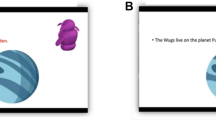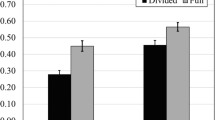Abstract
Trying to observe instruction in an active first-grade classroom can be a humbling experience. So much is going on and the distractions are so many, the wonder is that teacher and student make any sense of the situation. Yet they generally do—instruction and learning go on with a fair degree of success. The critical factor is attention. When the observer’s attention is properly focused, when he has learned what to look for and what to ignore, significant patterns become clear to him. Likewise, teacher and student work together effectively when each attends to the situation in an active, selective fashion.
Access this chapter
Tax calculation will be finalised at checkout
Purchases are for personal use only
Preview
Unable to display preview. Download preview PDF.
Similar content being viewed by others
References
Baker, R. W., & Madell, T. O. A continued investigation of susceptibility to distraction in academically underachieving and achieving male college students. Journal of Educational Psychology, 1965, 56, 254–258.
Ball, S., & Bogartz, G. A. A summary of the major findings in “The first year of Sesame Street: An evaluation.” Princeton, N.J.: Educational Testing Service, 1970.
Becker, W. C. Applications of behavior principles in typical classrooms. In C. E. Thoresen (Ed.), Behavior modification in education. The 71st Yearbook of the National Society for the Study of Education. Chicago: University of Chicago Press, 1972.
Berlyne, D. E. Conflict, arousal, and curiosity. New York: McGraw-Hill, 1960.
Broadbent, D. E. Perception and communication. London: Pergamon, 1958.
Broadbent, D. E. The hidden preattentive processes. American Psychologist, 1977, 32, 109
Brophy, J. E., & Good, T. L. Teacher-student relationships: Causes and consequences. New York: Holt, Rinehart & Winston, 1974.
Bruner, J. S. Beyond the information given: Studies in the psychology of knowing. New York: Norton, 1973.
Buckner, D. N., & McGrath, J. J. Vigilance: A symposium. New York: McGraw-Hill, 1963.
Calfee, R. C. Memory and cognitive skills in reading acquisition. In D. Duane & M. Rawson (Eds.), Reading, perception and language. Baltimore: York, 1975.
Cherry, E. C. Some experiments on the recognition of speech, with one and with two ears. Journal of the Acoustical Society of America, 1953, 25, 975–979.
Cobb, J. A. Relationship of discrete classroom behaviors to fourth-grade achievement. Journal of Educational Psychology, 1972, 63, 74–80.
Cobb, J. A., & Hops, H. Effects of academic survival skills training on low achieving first graders. Journal of Educational Research, 1973, 67, 108–113.
Craig, P. A., & Malgoire, M. A. Analyses of the Office of Education’s proposed rules for the identification of children with specific learning disabilities under the Education for All Handicapped Children Act. Unpublished manuscript, Menlo Park, Cal.: Stanford Research Institute, 1977.
Deutsch, J. A., & Deutsch, D. Attention: Some theoretical considerations. Psychological Review, 1963, 70, 80–90.
Dimmit, N. M. A study of training and photographic feedback methods for promoting accurate teacher perception of student attending behavior. Unpublished doctoral dissertation, Stanford University, 1970.
Doyle, R. B., Anderson, R. P., & Halcomb, C. G. Attention deficits and the effects of visual distraction. Journal of Learning Disabilities, 1976, 9 (1), 59–65.
Dunkin, M. J., & Biddle, B. J. The study of teaching. New York: Holt, Rinehart & Winston, 1974.
Easterbrook, J. A. The effect of emotion on the utilization and the organization of behavior. Psychological Review, 1959, 66, 183–201.
Egeland, B. Training impulsive children in the use of more efficient scanning techniques. Child Development, 1974, 45, 165–171.
Elman, A. The perception of transformation in geometry drawing. Paper presented at the American Psychological Association Convention, Montreal, 1973.
Fitts, P. M., & Posner, M. I. Human performance. Belmont, Cal: Brooks/Cole, 1967.
Forgus, R. H. Perception. New York: McGraw-Hill, 1966.
Gall, M. D., & Gall, J. P. The discussion method. In N. L. Gage (Ed.), The psychology of teaching methods. The 75th Yearbook of the National Society for the Study of Education. Chicago: University of Chicago Press, 1976.
Gough, P. B. One second of reading. In J. F. Kavanaugh & I. G. Mattingly (Eds.), Language by ear and by eye: The relationships between speech and reading. Cambridge, Mass.: M.I.T. Press, 1972.
Haber, R. N., & Hershenson, M. The psychology of visual perception. New York: Holt, Rinehart & Winston, 1973.
Hagen, J. W., & Hale, G. A. The development of attention in children. In A. D. Pick (Ed.), Minnesota symposium on child psychology (Vol. 7 ). Minneapolis: University of Minnesota Press, 1973.
Hagen, J. W., Jongeward, R. H., Jr., & Kail, R. V., Jr. Cognitive perspectives on the development of memory. In H. Reese (Ed.), Advances in child development and behavior (Vol. 10 ). New York: Academic, 1975.
Hochberg, J. E. Perception. Prentice-Hall Foundations of Modern Psychology Series, Richard S. Lazarus (Ed.). Englewood Cliffs, N.J.: Prentice-Hall, 1964.
Hudgins, B. B. Attending and thinking in the classroom. Psychology in the Schools, 1967, 4, 211–216.
James, W. The principles of psychology (Vol. 1 ). New York: Holt, 1890.
Kagan, J. Reflection-impulsivity and reading ability in primary grade children. Child Development, 1964, 36, 609–628.
Kagan, J. Developmental studies in reflection and analysis. In A. H. Kidd & J. L. Rivoire (Eds.) Perceptual development in children. New York: International Universities Press, 1966.
Kahneman, D. Attention and effort. Englewood Cliffs, N.J.: Prentice-Hall, 1973.
Keele, S. W. Attention and human performance. Pacific Palisades, Cal.: Goodyear, 1973.
LaBerge, D. Acquisition of automatic processing in perceptual and associative learning. In P. M. A. Rabbitt & S. Dornic (Eds.), Attention and performance. London: Academic, 1975.
LaBerge, D., & Samuels, S. J. Toward a theory of automatic information processing in reading. Cognitive Psychology, 1974, 6, 293–323.
Lahaderne, H. M. Attitudinal and intellectual correlates of attention: A study of four sixth-grade classrooms. Journal of Educational Psychology, 1968, 59, 320–324.
Lockhead, G. R. Processing dimensional stimuli: A note. Psychological Review, 1972, 79, 410–419.
Madsen, C. H., Jr., Becker, W. C., & Thomas, D. R. Rules, praise, and ignoring: Elements of elementary classroom control. Journal of Applied Behavior Analysis, 1968, 1, 139–150.
Maxwell, M. J. Skimming and scanning improvement: A program for self-instruction. New York: McGraw-Hill, 1969.
Meyers, C. E., Attwell, A. A., & Orpet, R. E. Prediction of fifth grade achievement from kindergarten tests and rating data. Educational and Psychological Measurement, 1968, 28, 457–463.
Morrison, H. C. The practice of teaching in the secondary school. Chicago: University of Chicago Press, 1925.
Navon, D. Global precedence in visual recognition. Unpublished doctoral dissertation, University of California, San Diego, 1975.
Neisser, U. Cognitive psychology. New York: Appleton-Century-Crofts, 1967.
Norman, D. A. Memory and attention: An introduction to human information processing. New York: Wiley, 1976.
Posner, M. I. Cognition: An introduction. Glenview, 111.: Scott, Foresman, 1973.
Posner, M. I., & Boies, S. J. Components of attention. Psychological Review, 1971, 78 (5), 391–408.
Premack, D. Reinforcement theory. In D. Levine (Ed.), Nebraska symposium on motivation. Lincoln: University of Nebraska Press, 1965.
Pribram, K. H., & McGuinness, D. Arousal, activation, and effort in the control of attention. Psychological Review, 1975, 82 (2), 116–149.
Ribot, T. The psychology of attention. London: Open Court, 1898.
Richards, I.A. How to read a page. New York: Norton, 1942.
Roper, S. S., & Nolan, R. R. How to survive in the open-space school. Occasional paper No. 10, Stanford Center for Research and Development in Teaching, School of Education, Stanford University, 1976.
Rosenshine, B. Classroom instruction. In N. L. Gage (Ed.), The psychology of teaching methods. The 75th Yearbook of the National Society for the Study of Education. Chicago: University of Chicago Press, 1976.
Ross, A. O. Psychological aspects of learning disabilities and reading disorders. New York: McGraw-Hill, 1976.
Rubin, D., Trismen, D. A., Wilder, G., & Yates, A. A descriptive and analytic study of compensatory reading programs. Phase I Report Contract No. OEC-71-3715. Princeton: Educational Testing Service, 1973.
Ryans, D. G. Characteristics of teachers: Their descriptions, comparison, and appraisal. Washington, D.C.: American Council on Education, 1960.
Samuels, S. J. Attentional processes in reading: The effect of pictures on the acquisition of reading responses. Journal of Educational Psychology, 1967, 58, 337–342.
Samuels, S. J., & Turnure, J. E. Attention and reading achievement in first-grade boys and girls. Journal of Educational Psychology, 1974, 66 (1), 29–32.
Schwebel, A. I., & Cherlin, D. L. Physical and social distancing in teacher-pupil relationships. Journal of Educational Psychology, 1972, 63 (6), 543–550.
Shannon, J. R. Measures of validity of attention scores. Journal of Educational Research, 1942, 35, 623–631.
Siegelman, E. Reflective and impulsive observing behavior. Child Development, 1969, 40, 1213–1221.
Silberman, C. E. Crisis in the classroom. New York: Random House, 1970.
Soar, R. S. Follow through classroom process measurement and pupil growth (1970–1971): Final report. Gainesville, Fla.: College of Education, University of Florida, 1973.
Sroufe, L. A., & Stewart, M. A. Treating problem children with stimulant drugs. New England Journal of Medicine, 1973, 289, 407–413.
Stallings, J. A., & Kaskowitz, D. H. Follow through classroom observation evaluation—1972- 1973. Menlo Park, Cal.: Stanford Research Institute, 1974.
Treisman, A. M. Verbal cues, language and meaning in selective attention. American Journal of Psychology, 1964, 77, 206–219.
Treisman, A. M. Strategies and models of selective attention. Psychological Review, 1969, 76, 282–299.
Welford, A. T. Fundamentals of skill. London: Methuen, 1968.
Werry, J. S., & Sprague, R. L. Hyperactivity. In C. G. Costello (Ed.), Symptoms of psychopathy. New York: Wiley, 1970.
White, S. H. Evidence for a hierarchical arrangement of learning processes. In L. P. Lipsitt & C. C. Spiker (Eds.), Advances in child development and behavior (Vol. 2 ). New York: Academic, 1965.
White, S. H. Some general outlines of the matrix of developmental changes between five and seven years. Bulletin of the Orton Society, 1970, 20, 41–57.
Wright, J. C. On familiarity and habituation: The situational microgenetics of information getting. Paper presented at the Symposium on Attention and Cognition, Society for Research in Child Development, New Orleans, 1977.
Wright, J. C., & Vlietstra, A. G. The development of selective attention: From perceptual exploration to logical search. In H. W. Reese (Ed.), Advances in child development and behavior (Vol. 10 ). New York: Academic, 1975, pp. 195–239.
Yerkes, R. M., & Dodson, J. D. The relation of strength of stimulus to rapidity of habit-formation. Journal of Comparative Neurology of Psychology, 1908, 18, 459–482.
Zivin, G. How to make a boring thing more boring. Child Development, 1974, 45, 232–236.
Author information
Authors and Affiliations
Editor information
Editors and Affiliations
Rights and permissions
Copyright information
© 1979 Plenum Press, New York
About this chapter
Cite this chapter
Piontkowski, D., Calfee, R. (1979). Attention in the Classroom. In: Hale, G.A., Lewis, M. (eds) Attention and Cognitive Development. Springer, Boston, MA. https://doi.org/10.1007/978-1-4613-2985-5_11
Download citation
DOI: https://doi.org/10.1007/978-1-4613-2985-5_11
Publisher Name: Springer, Boston, MA
Print ISBN: 978-1-4613-2987-9
Online ISBN: 978-1-4613-2985-5
eBook Packages: Springer Book Archive




